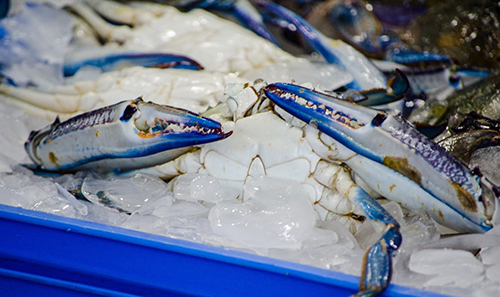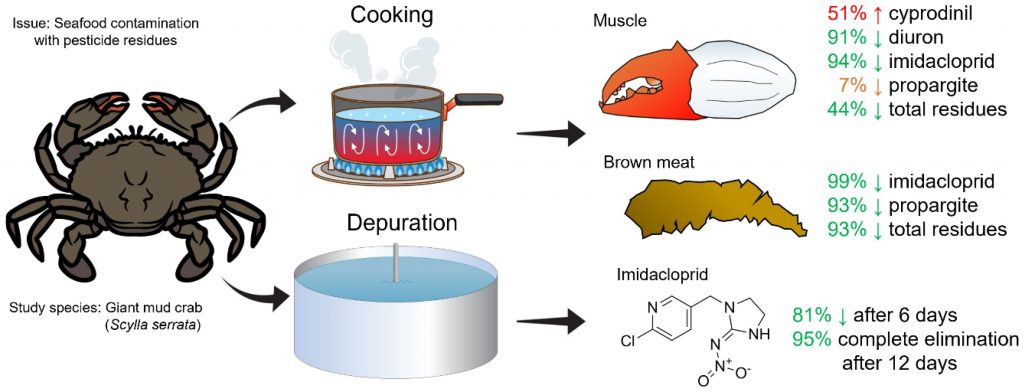Cleaner Crabs: Adapting Seafood Safety for a Changing Climate
- Adaptation story
- New South Wales

In the muddy estuaries of northern New South Wales, two of Australia’s most iconic crustaceans – the Giant Mud Crab (Scylla serrata) and the Blue Swimmer Crab (Portunus armatus) – are caught in the crosscurrents of climate change. Intensifying rainfall and flooding events are washing more agricultural chemicals into coastal waterways, raising new concerns for seafood safety, fisher livelihoods, and ecosystem health.
But a team at Southern Cross University’s Catchments, Coasts and Communities research cluster is showing that adaptation is possible, even after the catch.
PhD researcher Benjamin Gray has been investigating how flooding events expose crabs to pesticides. In a recent global review, he and his coauthors showed that contaminants carried by rainfall – including metals, pesticides, and PAHs – consistently harm estuarine decapods, threatening fisheries sustainability and food security under future climate variability (Gray et al. 2025a).

Supported by FRDC Project 2022-010 and SafeFish (FRDC Project 2021-018), Benjamin’s field research revealed a similar story closer to home: chemical residues were consistently detected in wild-caught crabs. The results were sobering but also encouraging – cooking or holding crabs in clean seawater significantly reduced residues, with imidacloprid almost completely eliminated (Gray et al. 2025b). In other words, smarter post-harvest handling can help safeguard consumers and markets, even as climate extremes increase contamination risks.

For Benjamin, the work is both scientific and personal. Living in northern NSW through the La Niña floods of 2020 – 2023, he witnessed firsthand the mass fish kills and crab deaths that followed: “We need to be better prepared for how we manage our fisheries and protect seafood safety during extreme floods,” he says.
The project is grounded in collaboration. Commercial crab fishers have been central to the research, collecting samples, sharing insights on pollution hotspots, and helping test solutions in real estuaries. Their knowledge is shaping how scientists trace contamination pathways from catchments to crabs, ensuring results are both practical and trusted by industry.
This research highlights a bigger story of adaptation. As climate change fuels more frequent floods, fisheries will need new strategies to maintain seafood safety and consumer confidence. Post-capture techniques like depuration and cooking offer immediate, low-cost tools. At the same time, the findings underscore the urgent need for better land-use management to reduce chemical runoff at its source.
“Restoring riparian vegetation is essential to help reduce the amount of contaminated sediment entering our waterways after big rain fall events” says project supervisor Professor Kirsten Benkendorff, further stating,
“We are also investigating evidence-based mitigation strategies, such as the use of bioreactors to catch and degrade pesticides from hothouse run-off”. More of Professor Benkendorff’s and co-author’s work on bioreactors can be found here.
From catchment to coast, the crab story is one of resilience: fishers and scientists working side by side to safeguard seafood in an uncertain climate. By adapting how we handle seafood post-capture, and by tackling pollution upstream, Australia can ensure that its estuarine fisheries remain healthy, sustainable, and resilient for generations to come.
Read more about Ben’s latest research here: https://doi.org/10.3389/fmars.2025.1624922
FRDC Story: https://tinyurl.com/ypr29nef
Citations:
Gray, B.C., Champion, C., Broadhurst, M.K., Coleman, M.A. and Benkendorff, K., 2025. Effects of contaminants and flooding on the physiology of harvested estuarine decapod crustaceans: A global review and meta-analysis. Environmental pollution, 364, p.125347. https://doi.org/10.1016/j.envpol.2024.125347
Gray, B.C., Champion, C., Broadhurst, M., Coleman, M.A. and Benkendorff, K., 2025. Efficacies of cooking and depuration for reducing current-use pesticide residues in wildcaught giant mud crabs (Scylla serrata). Frontiers in Marine Science, 12, p.1624922. https://doi.org/10.3389/fmars.2025.1624922
Ewere, E.E., White, S., Mauleon, R. and Benkendorff, K., 2024. Soil microbial communities and degradation of pesticides in greenhouse effluent through a woodchip bioreactor. Environmental Pollution, 359, p.124561. https://doi.org/10.1016/j.envpol.2024.124561